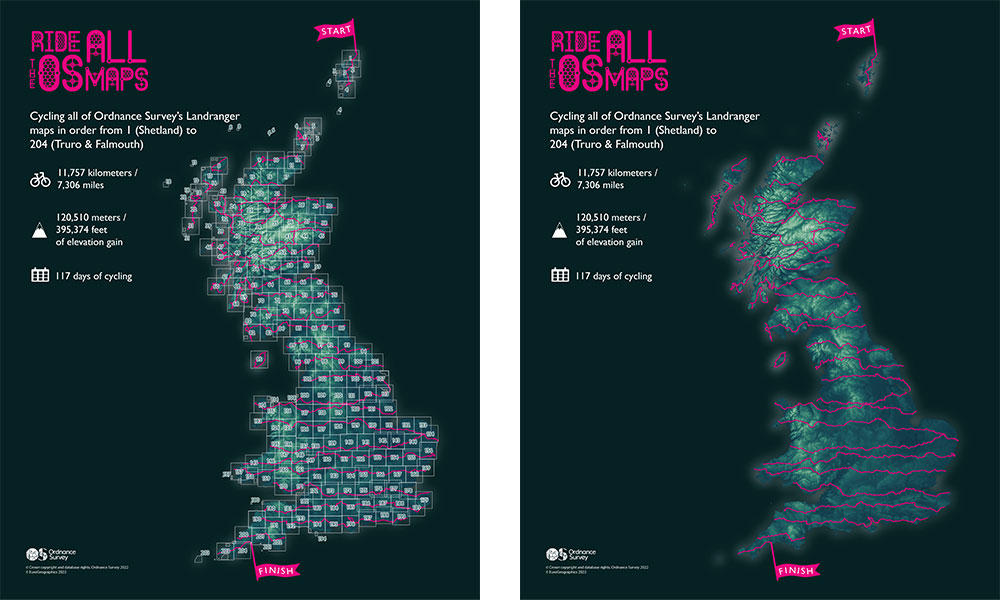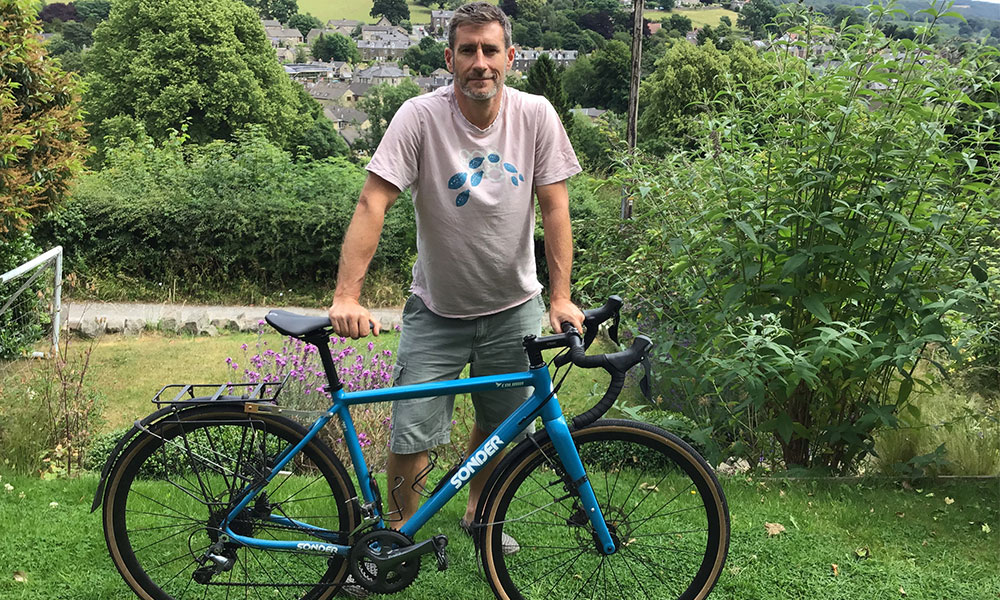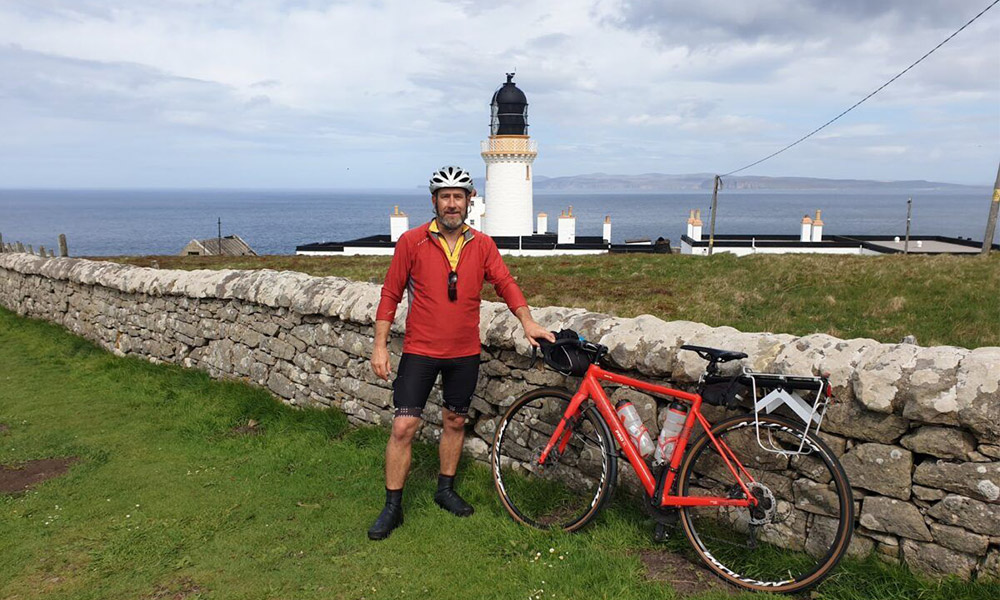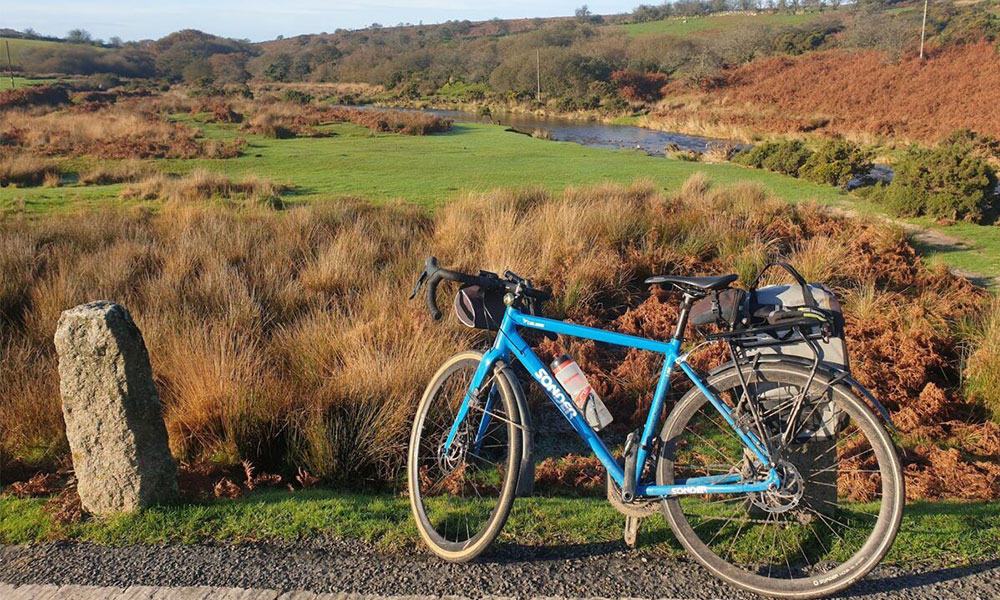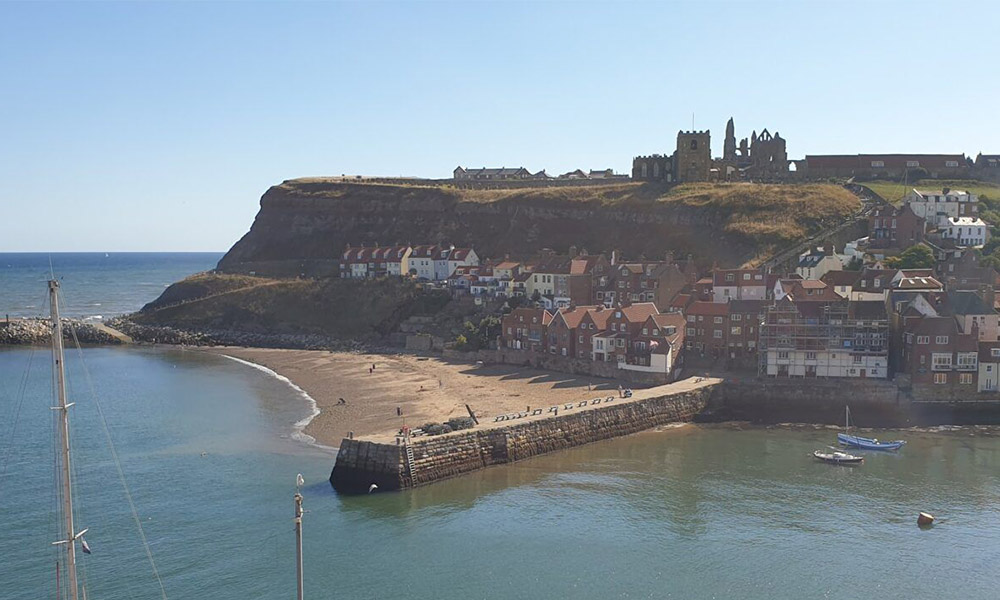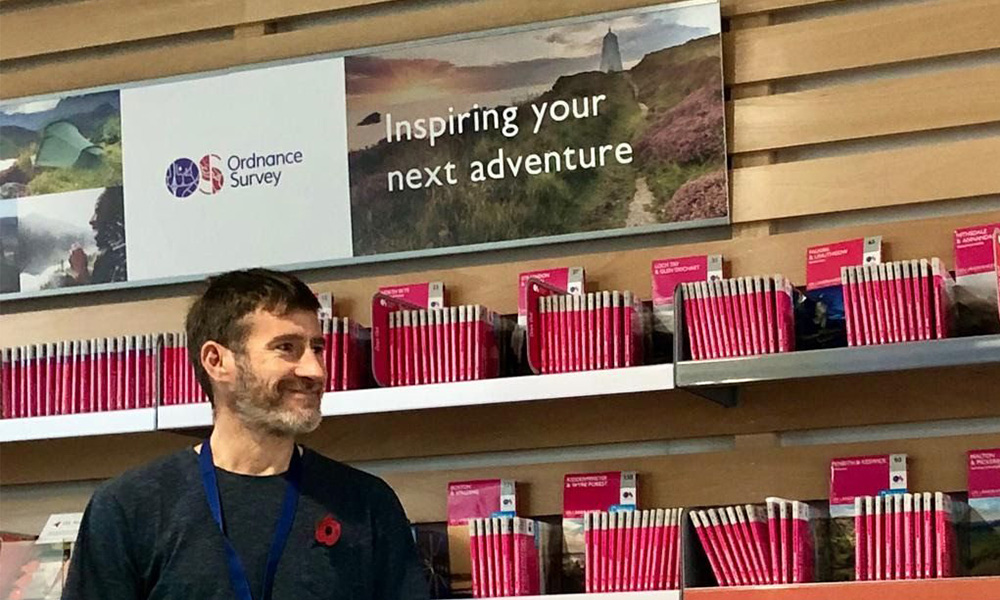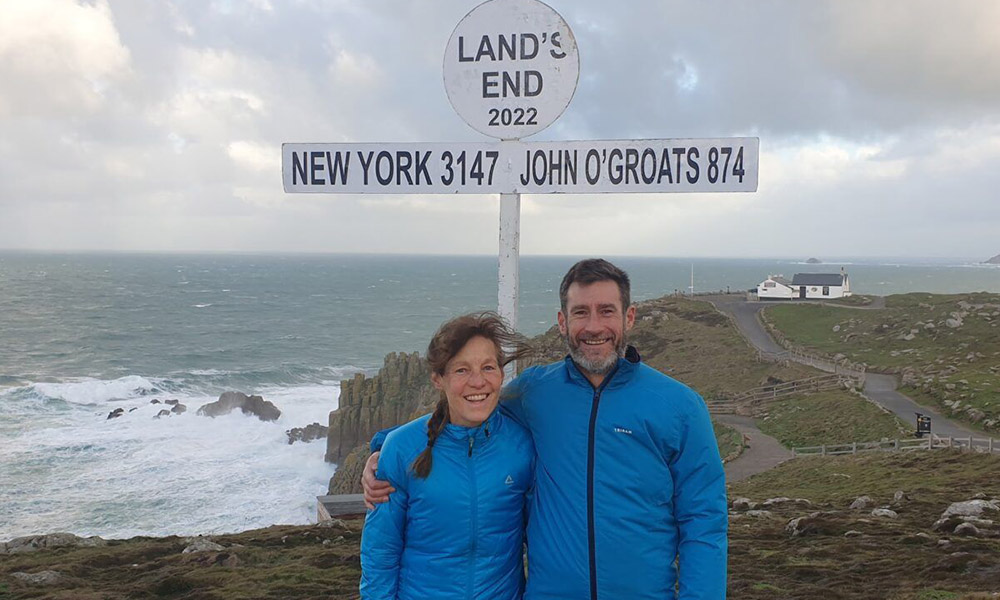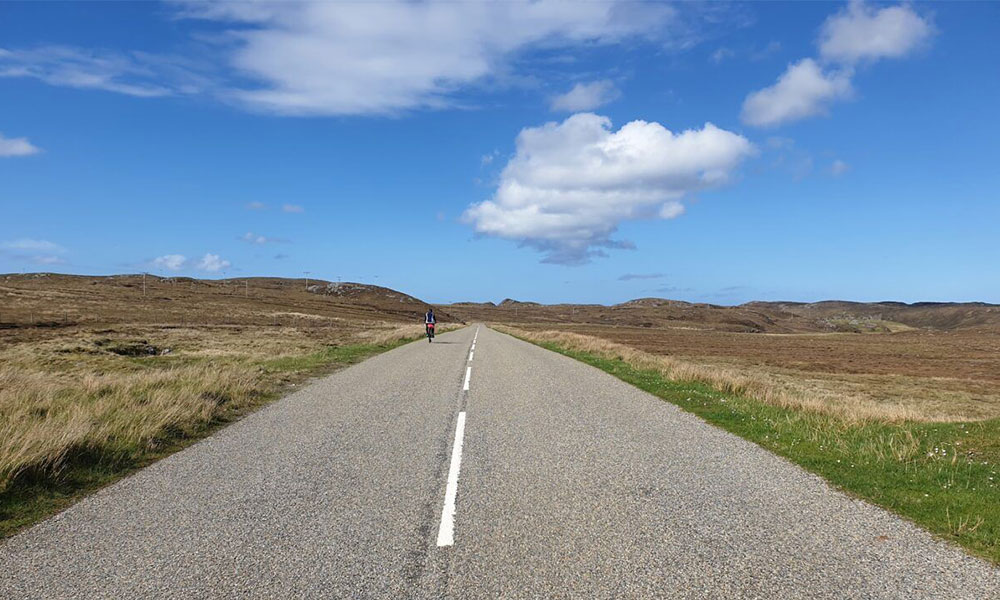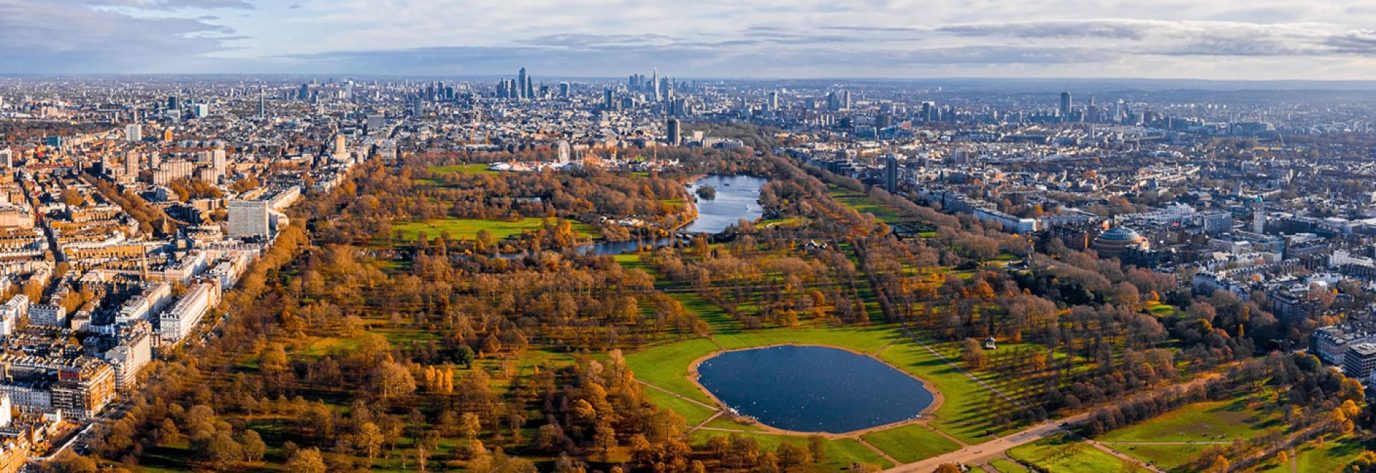Riding through all 204 OS Landranger maps
Mark Wedgwood took on the epic challenge to cycle Britain, passing through all 204 OS Landranger Maps. Find out what he learnt from his trip and get some great advice on multi-day adventures and cycling in Britain.
Starting from map sheet #1 in Shetland (Scotland), Mark pedalled over 7300 miles (11,700km+) across the nation ticking off each map in consecutive order until he reached #204 in Cornwall. After 117 days in the saddle, Mark arrived home where we caught up with him to hear how it went.
Welcome back Mark, how do you feel to be home?
Thank you. It is nice to be back! I live in a beautiful part of the country and am lucky to have great friends and family to catch up with. I will confess to having mixed feelings that there is no more cycling left to do in this adventure. However, it is the middle of winter and mostly cold, grey and/or dark outside, so I feel less of a sense of loss, because what I did for 6 months really isn’t possible at this time of year.
Much of my time and energy since completing the final few maps has been directed at making the next adventure possible. That starts with a very long flight to Ushuaia, Argentina – the city at the bottom of the world – where I am privileged to be joining members of my American family on an Antarctic cruise. Another trip of a lifetime (if that is possible!). While I am so far from home, I am following it with two months of trekking and travelling in the Andes with my wife. That has certainly taken care of any post-cycling questions around “what next?”.
The cycle route
Was there a particular experience that will stay with you forever – good and bad!
Perhaps this is a bit of a cheat, since I wasn’t technically cycling at the time; but this adventure gave me the best excuse ever to visit St Kilda. This remote archipelago sits in a small box on the left edge of OS Landranger map 18, and at the western extremity of Europe. I certainly worked hard to get there and it was expensive too. It was a truly amazing day in an incredible vertical world, far removed from anything we would think of as either a normal or comfortable existence. Altogether an experience that I will never forget.
I didn’t really have an unforgettably bad experience, l am pleased to report. The closest would probably be two separate occasions on the Isle of Skye when a combination of a vicious headwind and rain forced me to stop cycling and take shelter out of sheer blindness. One of those times I chanced upon a bus shelter, complete with wooden chair. On the other occasion – my birthday – there was nowhere to hide! Things did get better and people were always helpful and sympathetic.
Are there any places you will return to?
Yes, far too many to list! My 7,000 plus mile journey was full of wonderful places and I was rarely able to spend very long in any of them. I knew it would have to be like that, so I always saw this as a kind of reconnaissance mission for where I should return. I feel I have a lifetime’s worth of places to do justice to now. It has made me even more curious about them than before.
What was the most challenging part of the route?
Different parts for different reasons. The first few weeks in Shetland, Orkney and the The Hebrides were by far the windiest, and that can be a serious challenge for any cyclist. There were also route planning challenges brought about by the regular need to shuttle between the mainland and the many Scottish islands, along with the constraints of the ferries and ports that serve them; but that was always fun.
Later, in the more populous parts of England especially, a constant challenge was how to find the best way to avoid traffic and stay on course, without straying outside the boundaries of each map. I only had OS Maps on my phone, which was great for navigation but what I needed was a big bird’s eye view of each day of west to east riding. So, I had to rely on my wife’s assistance, relayed to me from the OS Landranger paper maps she had spread out across our kitchen table. Some days it was like threading a needle; but we always found a way that worked. You could only plan like this a day at a time, so each evening was an exercise in finding the next day’s route, and then it was a case of joining the dots on the ground as I went.
Describe your adventure in three words


“Rejuvenating. Enlightening. Complicated.”

Was it easy to find food, drink and accommodation on the route?
I organised very little more than a day or two in advance, except in the early stages when I was riding in more remote places with fewer options at popular times. In northern Scotland in summer, everything was at a premium. You quickly learned the importance of thinking ahead and booking. Otherwise, you might not get a meal. Later on in the trip it was not generally an issue. It was often quite hard to predict exactly where I might be, or when, due to the large number of variables. I would pass on to other cyclists the advice given to me before I started: never pass an open café!
The kit
What bike did you use and how did you choose the bike?
The bike I used for most of the trip was a new Sonder Calibri AL that I bought specifically for the task. It is a touring bike made for carrying luggage every day, and I bought it from the Alpkit shop in my own village, Hathersage. That made it much easier to choose and try out, as well as keep it running smoothly on visits home. They were really helpful and supportive. While price was a limiting factor, my choice was as much dictated by the lead times for the different models, so in some ways it chose itself.
How much did you know about bike mechanics beforehand?
Probably not enough, but it has never been an area of strength. I have been cycling most of my life and my skills are sadly limited. I can get myself out of a flat tyre. I am out of my depth much beyond that. I did carry a few essential spares and thankfully didn’t need most of them.
Any items you wish you had packed?
A better iPad for the first few weeks. I rectified that. Writing takes long enough without technology slowing you down even further. I also added a pair of crocs and a power pack to my kit after a month or so and would always carry them both in the future. And probably a spare set of pedal cleats. I seemed to wear them out with surprising speed and found them difficult to replace.
Anything you wish you left at home?
Nothing comes immediately to mind. I carried a few paper OS Landranger maps to start with; but they were really something of a luxury. I looked at them and enjoyed each one briefly; but each became redundant as soon as I crossed it. It then took up space and weight, which is bad news for a cyclist! Since there were 204 maps to cycle across, I reluctantly managed without after my first trip back home.
How much did your kit and bike weigh?
My bike weighs in at 10kg, according to Sonder. I carried two rear panniers with me most days, although they were not completely full. I would guess that each one weighed between 4 and 5kg. What I can say is that the bike and me weighed as much at the start of the trip as the bike, me AND the two panniers at the finish!
Any top tips for someone going bikepacking or cycle touring for the first time?
• If you can afford it, treat yourself to a proper bed and a hot shower every night.
• Remember that a cyclist runs on fuel and you need to keep putting it in. Breakfast has never been more important to me!
• Take only what you really need; but take enough of the right clothes for all weathers and have something dry to change into when you are not cycling.
• Put everything in plastic bags!
• Taking a bike on a train is not hard but requires some planning so, give yourself extra time. Ask for help from staff if you need it, they are generally very good.
• Think ahead about where you will get refreshments en route each day. Google Maps is useful for finding places to stop and opening hours. Know your best options and carry some emergency rations just in case things don’t go to plan.
• Carry a couple of spare inner tubes and know how to fit them.
• Have good lights and keep them fully charged.
• Take pictures to keep your memories fresh.
• Don’t let Google Maps tell you where to go. Learn to read an OS Map and take them with you on your phone. You will always know where you are and can quickly see if you are on the wrong road. Avoid main roads, large towns and traffic wherever possible. I enjoyed thousands of miles of delightful, peaceful cycling in every part of Britain. The only significant exceptions were when I could not escape busy roads. But that is rarely necessary with good planning.
• Use ferries: island hopping is great fun and takes you to a new world every day. Most ferries are heavily subsidised, and not expensive.
• Keep daily distances well within your range, and take time out from cycling every day, and altogether every few days, so that it is always fun!
Navigation
How did you find navigation on your bike, did you get lost?
I mostly managed not to get lost. I certainly took wrong turns, especially when the road network became denser and more complicated in the Midlands and the south of England. But I usually knew enough about my intended route that I could soon tell if it felt wrong. I would check whenever I needed to and make the occasional correction. The little dot that tells you where you are on the OS Map app is an extremely valuable tool. With that and a good sense of direction I was generally fine. I don’t like following a machine slavishly (so I don’t use SatNav in a car, for example) because I think you need to be able to get there using your own skills. Part of the point of this adventure was the OS Landranger maps I was crossing, so I wanted to interact with them as I went, rather than preload a computerised route. I understand why that works for others; but it would be missing the point for me. I wanted to be master of my own route each day and I enjoyed the challenge of finding the best way to join my dots by bike. It worked out pretty well.
Did you carry a back up to your phone?
I was always concerned about running out of phone battery. I was running Strava all the time and it sucked power away. I coped for a while by plugging it in to recharge at every place I stopped to eat or drink; but that was inconvenient and not always reliable. That is why I started to carry a power pack and it got me out of trouble many times. The other important thing was to keep everything dry. I was incredibly lucky with the weather; but when it does rain, things get wet very quickly. You need to be able to protect everything, even the things in your pockets. On the few occasions I lost my phone battery altogether, I was navigating blind, or forced onto main roads, and I might not even know how to find where I was staying at the end of the day. Not ideal. It led to the occasional impromptu pub or café stop!
Did you record your route?
Yes, I recorded everything using Strava. I hadn’t bothered with that before, but I was asked to do it and I am glad I did. It led to a few phone issues and I regularly forgot to switch it on or off. But with the help of the Ordnance Survey, I now have an amazing digital image of my entire journey, which is going to be printed and framed on my wall.
Final thoughts
What have you learnt from this experience that you’ll use on your next adventure?
One of the motivations for this adventure was to see if I would enjoy doing something on this scale on a bike. I have learned that I did, and I think I learned how to keep it fun all the time. That means I can now look at more exotic possibilities beyond our own shores with much greater confidence. I have also learned that I am happy in my own company and like to make my own decisions; but can equally enjoy any company that comes my way. It was nice sometimes to simply let someone else take charge for a day.
I have learned that it is hugely rewarding to involve many other people in something like this and that they can be incredibly generous. I have learned of the delights of cycling in the long, light evenings of midsummer in the mountains of Scotland, and the challenges of making satisfactory progress anywhere when the days are short. I have also learned that I appear to be quite well suited to this type of challenge, one that is done my way and without setting out to prove anything to anyone. That, with the right preparation and equipment, can be a truly uplifting and rewarding life experience. I have also learnt that you need support to succeed, and that an individual challenge is really a team effort.
If someone is thinking about a long-distance cycle challenge, where should they start?
I don’t think one size fits all, so it is important to choose something that will work well for you. Bottom line for me – always – is that however challenging it gets it must be enjoyable as well. That probably means finding something that won’t be easy; but is achievable. You need to be inspired by what you are doing and it helps if it has a purpose. Don’t think about whether you can do it. Think about how you WILL do it and go from there.
What are your future plans?
I have a completely open mind about the future but there will be more adventures, for sure. Life should be one big adventure. The world is a very big place and I don’t want to put off forever what I can be doing now, in case I lose that chance for good. No one knows what lies around the corner. In the short term I will enjoy the rest of the British winter out in South America (where it will be summer). And then return home for the spring, which is my favourite time of year.
I have many ideas about possible trips that may or may not involve cycling but I will always want to be outdoors in nature and doing something active. In the last couple of years, I completed a couple of ultra “running” events (I use the term loosely), which were tough and took me well beyond what I had done before. I think attrition works well as you get a little older. You may not be so quick anymore; but you can certainly keep going, mentally and physically, if you prepare well. My longest “run” was 100km in a day. I have an idea that I might do something like that again if I can find the right place and time. The preparation is great fun, too. Lots of increasingly long walks in the countryside taking me new places, walking up and running down the hills and the odd café stop. It fits well with my rule of always enjoying it. Whatever I do, it should be something that helps keep me fit, healthy and – if possible – young!
Hear more about Mark’s epic adventure to cycle all 204 OS Landranger maps in this article from when we caught up with him during his trip.

